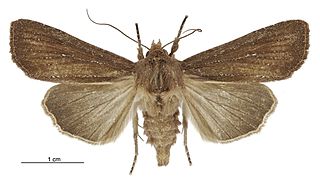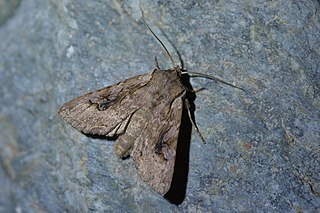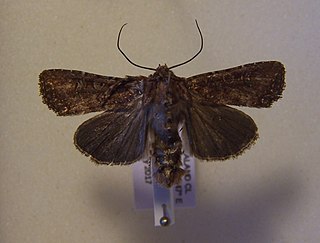
The Rock and Pillar Range of high hills is located in the Maniototo, an area of inland Otago, New Zealand. They are surrounded by the Taieri River, which has its source in the range, flowing out across the scroll plain at Paerau, before almost doubling back on itself at Waipiata and flowing back along the other side through the Strath-Taieri. The town of Middlemarch lies close to the Taieri to the east of the range, and Patearoa lies to the northwest.

Ichneutica lissoxyla is a moth of the family Noctuidae. It is endemic to New Zealand. It is found in the central and southern parts of the North Island and in most parts of the South Island. The species prefers snowgrass habitat in the alpine zone. I. lissoxyla is similar in appearance to I. paraxysta but can be distinguished as I. lissoxyla lack the black streaks on the forewings that can be found on the latter species and the male I. lissoxyla also has longer pectinations on antennae. The life history of this species is unknown as are the host species of its larvae. Adults are on the wing from January to April and are attracted to the light.

Ichneutica pelanodes is a moth of the family Noctuidae. It is endemic to New Zealand and has been found in scattered locations in the North, South and Stewart Islands. I. pelanodes is easily confused with I. skelloni as the two species are visually extremely similar. In the North Island though the range of the two species appears not to overlap. Generally of the two species I. pelanodes tends to be darker in appearance. I. pelanodes inhabits wetlands but the life history of this species is unknown as are the host species of its larvae. Adults are on the wing from October to February and are attracted both to sugar and light traps.

Ichneutica petrograpta is a moth of the family Noctuidae. This species is endemic to New Zealand where it is found in the southwest districts of the South Island, including Westland, Otago Lakes and Fiordland. It is very similar in appearance to I. mutans. It inhabits tussock and shrubland in the alpine to subalpine zones. Adults of I. petrograpta are on the wing from December to February and are attracted to sugar traps. The life history of this species is unknown as are the host species of its larvae.

Ichneutica micrastra is a moth of the family Noctuidae. It is endemic to New Zealand. This species has been found only in the North Island and has been collected in the Northland, Auckland, Whanganui and Wellington regions. The preferred habitat of this species is wetlands and heathlands including gum fields in Northland. Adults of this species are on the wing from October to December. The life history of this species is unknown as are the host species of its larvae however it has been hypothesised that the likely larval host is a grass or grass like plant. This species is very similar in appearance to I. phaula and I. sapiens but can be distinguished as a result of differences in male antennae, the shape, colour and size of forewings, the range of the species as well as differences in genital shape.

Ichneutica fibriata is a moth in the family Noctuidae. It is endemic to New Zealand. Specimens of this moth were first collected by Frederick Giles Gibbs. The species is similar in appearance to other species in the Ichneutica genus particularly I. eris but can be distinguished due to its larger size and more uniform light grey colour. I. fibriata also has a similar coloured thorax and head where as these two anatomical features may differ in colour shade in I. eris. Adults frequent alpine areas and are on the wing in November to January. The life history and the host species of the larvae of this species is unknown.

Ichneutica cana is a moth of the family Noctuidae. It is endemic to New Zealand.
Ichneutica dundastica is a moth of the family Noctuidae. This species is endemic to New Zealand. As at 2019 this species has only been found near the Dundas Hut in the Tararua Range near Wellington. It inhabits alpine shrubland and is attracted to light. The life history of this species is unknown as are the host species of its larvae however adults are on the wing from late November to early December. The female of the species is larger and more conspicuous than the male.
Ichneutica peridotea is a moth of the family Noctuidae. This species is endemic to New Zealand. The species is similar in appearance to Ichneutica plena but are more dull olive-green in appearance and the male lacks the patches of orange-brown forewing scales of the male I. plena. As at 2021 I. peridotera has only been collected in the Auckland District although Robert Hoare hypothesises that its range may include the northern districts of the North Island. The lack of information about this species is partially due to the fact it is late winter flying. The life history of this species is unknown as are the hosts of its larvae. Its preferred habitat is forest and the adults are attracted to light.
Ichneutica cornuta is a moth of the family Noctuidae. This species is endemic to New Zealand and is only found in the South Island, in and around the Southern Alps. I. cornuta is very similar in appearance to pale forms of I. arotis. It is easy to confuse the two species as their ranges overlap. Male I. cornuta can be distinguished as it has longer pectinations on the antennae and the female lacks the dark scaling that can be found on the thorax of the I. arotis. There are also subtle differences in the forewing patterns of the two species. The life history of this species is unknown as are the host species of its larvae. Adults are on the wing from January to April.
Ichneutica emmersonorum is a moth of the family Noctuidae. This species is endemic to New Zealand. It is very similar to I. similis but its forewings have visual differences. I. emmersonorum is only known from the North Island volcanic plateau. The life history of this species is unknown as are the host species of its larvae however Robert Hoare argues that the likely larval host plant species is a grass or grass like plant. The adult moths are on the wing from November to January. This species is attracted to sugar traps and to light.
Ichneutica theobroma is a moth of the family Noctuidae. This species is endemic to New Zealand. The males of this species has a pink chocolate brown appearance to its forewings with a small white dot. The males of this species can be distinguished from the 'northern dark form' of Ichneutica arotis as they have broader shaped forewings with less markings than the latter species. The females are extremely difficult if not impossible to tell apart. I. theobroma are found in the northern parts of the North Island and inhabit kauri forests. The life history of this species is unknown as are the host species of its larvae although it has been hypothesised that larval hosts include Gahnia setifolia and Gahnia xanthocarpa. Adults of this species are on the wing from mid September until early November and are attracted to light.
Ichneutica lyfordi is a moth of the family Noctuidae. This species was named in honour of its first collector, Brian M. Lyford, and is endemic to New Zealand. It is only known from the Von Valley in the Otago Lakes area of the South Island. As at 2021, only the male of the species has been collected. The life history of this species is unknown as are the host species of its larvae. Adults are on the wing in February and are attracted to light.
Ichneutica prismatica is a moth of the family Noctuidae. This species is endemic to New Zealand. The species is ochreous coloured with distinctive pale streaks on its forewings and a white fringe on its hindwings. It is similar in appearance to I. paraxysta but I. prismatica is smaller, lighter bodied and has narrower wings. Also I. prismatica can only be found in the South Island where as I. paraxysta is only known from the North Island. I. prismatica has mainly be collected in the Central Otago region but has also been recorded in the Otago Lakes and the wider Dunedin regions. It inhabits tussock grasslands and wetlands. The life history of this species is unknown but the larval host species are found in the genus Chionochloa. Adults are on the wing in December and January and have been recorded as flying during the day.
Ichneutica haedifrontella is a moth of the family Noctuidae. This species is endemic to New Zealand. It is only known from scattered areas in the North and South Islands. In the North Island it has only been collected in the Pouakai Range in Taranaki. In the South Island it is known from the Nelson, Buller, North Canterbury, Otago Lakes and Fiordland regions. It inhabits alpine to subalpine zones. The life history of this species is unknown as are the host species of its larvae in the wild. Larvae have been reared on species in the Chionochloa genus. Adults are on the wing from December to February and are attracted to light. This species has a smaller dwarf form that can be found in the Pouakai Range and at Dart Hut.

Ichneutica lindsayorum is a moth of the family Noctuidae. This species is endemic to New Zealand and can be found in the southern parts of the North Island and in the South Island. I. lindsayorum is very similar in appearance to I. olivea but has a longer basal streak and lacks the white scaling from the subterminal line on the forewing that can be found on the forewings of I. olivea. The life history of this species is unknown as are the host species of its larvae in the wild. However larvae have been reared on Ozothamnus leptophyllus. The adults of this species are on the wing from December to April.
Ichneutica seducta is a moth of the family Noctuidae. This species is endemic to New Zealand. It is found only in the Chatham Islands and inhabits native forest. The life history of this species is unknown but the larval host species is likely to be Dracophyllum arboreum. The adults of this species are on the wing from November to January and are attracted to light.

Ichneutica mustulenta is a moth of the family Noctuidae. This species is endemic to New Zealand is widespread throughout the North, South and Stewart Islands. I. mustulenta prefers damp native forest in the west of the North and South Islands. Its range only overlaps with its close relative I. morosa in a few places such as Taranaki. The life history of this species is unknown as are the host species of its larvae. However it is assumed that the larval hosts of this species will be grasses similar to its close relatives in the same genus. Adults of this species are on the wing from January to March.
Ichneutica supersulcana is a moth of the family Noctuidae. This species is endemic to New Zealand and is only known from the Tararua Ranges and at Tongariro National Park. This species has been collected in subalpine tussock grasslands as well as subalpine shrubland and at the margins of Fuscospora cliffortioides forest. The life history of this species is unknown as are the host species of its larvae. The adults of this species are on the wing in February and are attracted to light. It appears to be restricted to higher altitudes in comparison to its close relative I. sulcana.I. sulcana and I. supersulcana are very similar in appearance with no reliable visible differences between the two having been discovered. However, there are distinct differences in the male abdomen and genitalia of these two species.
Ichneutica thalassarche is a moth of the family Noctuidae. This species is endemic to New Zealand and is only found in the Chatham Islands. It has been collected at Chatham Island, Pitt Island and Rangatira Island. The life history of this species is unknown as are the host species of its larvae. The adults of this species are large with a pale grey throax and forewing. A diagnostic feature is the pattern on its forewing which is a white subterminal line joined by black "teeth" markings. This species has been recorded as a winter flyer having been collected in June to August.








